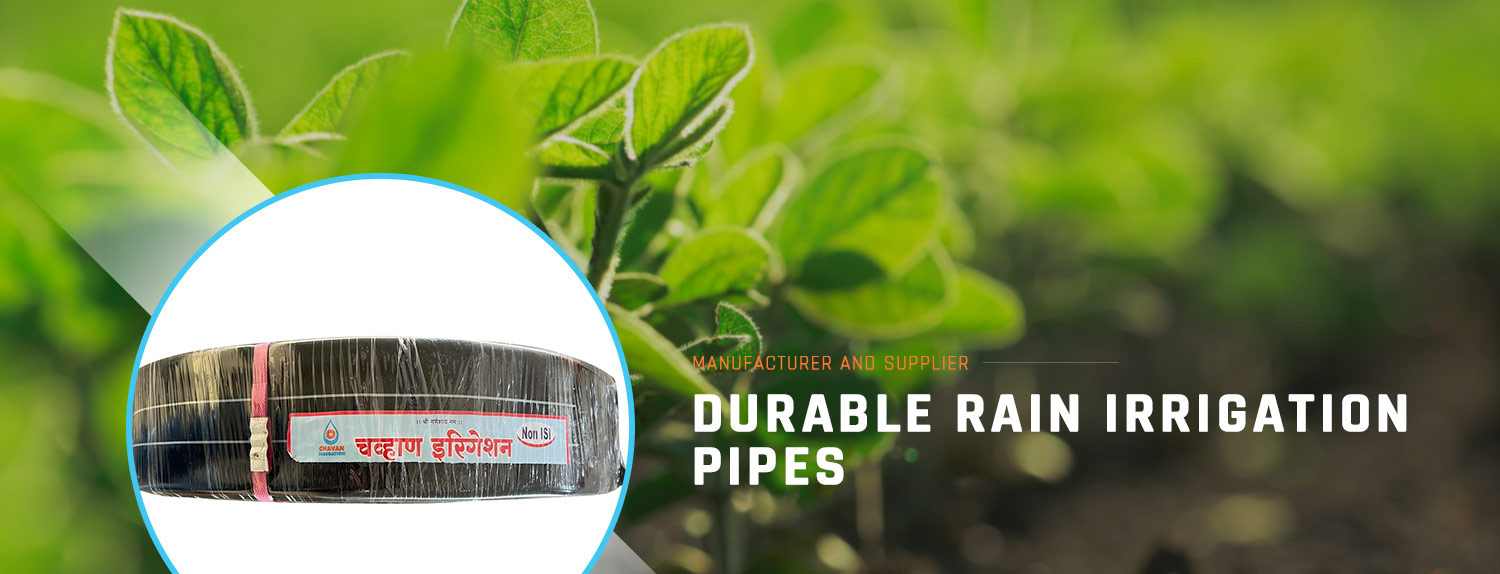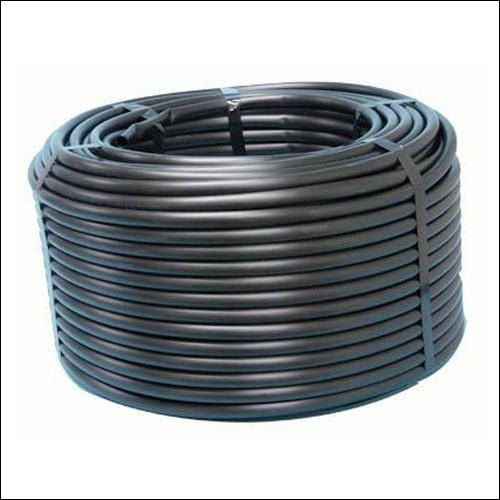Call Us : 08045814301


Drip Irrigation Pipes
3.00 - 6.00 INR/Meter
Product Details:
- Product Type Drip Irrigation Pipes
- Material Rubber
- Application Agriculture
- Click to view more
X
Drip Irrigation Pipe Price and Quantity
- 100 Meter
- 3.00 - 6.00 INR/Meter
Drip Irrigation Pipe Specifications
- Rubber
- Agriculture
- Drip Irrigation Pipes
Drip Irrigation Pipes Trade Information
- Cash Advance (CA)
- 10 Days
- All India
Product Description
We are offering a wide array of Drip Irrigation Pipes. These are able to deliver water and nutrients directly to the plant's roots zone. These are made with a premium quality of polypropylene material to ensure tear and chemical resistant. These pipes are useful to prevent overwatering and reduce water usage. Drip Irrigation Pipes are suitable for water applications. These pipes are easy to fold and connect with other pipes without any worry.
Applications of Drip Irrigation Pipe:
1. Agriculture: Drip irrigation is extensively used in agriculture for various crops such as vegetables, fruits, nuts, grains, and field crops. It helps optimize water usage and nutrient delivery, resulting in improved crop yields and quality.
2. Orchards and Vineyards: Drip irrigation is particularly beneficial for fruit-bearing trees and vines. It ensures that water reaches the root zone directly, minimizing water wastage and reducing the risk of fungal diseases that can result from wet foliage.
3. Greenhouses and Nurseries: Drip irrigation is commonly used in controlled environments like greenhouses and nurseries. It provides precise water and nutrient delivery to young plants and seedlings, promoting healthy growth.
4. Flower Beds and Landscaping: Drip irrigation is effective for maintaining flower beds, shrubs, and ornamental plants. It prevents water runoff and evaporation, ensuring that water is delivered directly to the plants' root zones.
5. Urban and Residential Landscaping: Drip irrigation is popular for residential gardens and landscapes. It allows homeowners to efficiently water lawns, flower beds, shrubs, and trees while reducing water usage.
6. Hedges and Hedgerows: Drip irrigation can be used to establish and maintain hedges and hedgerows. It ensures consistent moisture along the hedge, promoting uniform growth.
7. Sloped or Uneven Terrain: Drip irrigation is effective on sloped or uneven terrain where traditional sprinkler systems might result in water runoff and uneven coverage. The controlled water delivery of drip irrigation helps prevent erosion and ensures even watering.
8. High-Wind Areas: Drip irrigation is suitable for regions prone to high winds, as it minimizes water wastage due to wind drift and evaporation that can occur with traditional sprinklers.
9. Water-Scarce Areas: Drip irrigation is especially valuable in arid and water-scarce regions, as it maximizes water efficiency and ensures that each drop of water is utilized by plants.
10. Organic and Sustainable Farming: Drip irrigation aligns well with organic and sustainable farming practices, as it reduces the need for chemical fertilizers and pesticides by delivering nutrients directly to the root zone.
11. Frost Protection: In cold climates, drip irrigation can be used for frost protection by applying a consistent flow of water that freezes and forms a protective layer of ice around plants, insulating them from extreme cold.
12. Drought-Resistant Landscaping: Drip irrigation is ideal for creating drought-resistant landscapes, including xeriscaping and native plant gardens, by delivering water precisely where it's needed.
13. Row Crops and Raised Beds: Drip irrigation is well-suited for row crops and raised beds, delivering water between rows or directly to the base of plants.
14. Hydroponics and Container Gardening: Drip irrigation is used in hydroponic systems and container gardening setups to provide nutrient-rich water to plants grown in soilless mediums.
How Drip Irrigation Pipe Works?
Drip irrigation is a method of delivering water directly to the root zone of plants in a controlled and efficient manner. Drip irrigation pipes, also known as drip lines or drip tubing, play a crucial role in this irrigation system. Here's how drip irrigation pipes work:
1. Water Source and Pressure Regulation: The system begins with a water source, which can be a water faucet, a water tank, or a well. The water is typically filtered to remove debris and sediment that could clog the drip emitters (small outlets that release water). The water pressure is then regulated to ensure a consistent flow rate throughout the system.
2. Main Supply Line: The drip irrigation pipe is typically made of polyethylene (PE) or other suitable materials. It consists of a main supply line that carries water from the water source to various parts of the garden or field. The main supply line is laid out along the rows of plants that need to be irrigated.
3. Subsidiary Lines: From the main supply line, subsidiary or lateral lines are connected to deliver water to individual plants or groups of plants. These lateral lines are usually narrower and can be of various lengths depending on the spacing of the plants.
4. Emitters: Emitters are the devices attached to the lateral lines that release water in a controlled manner. There are various types of emitters available, including drippers, micro-sprinklers, and soaker hoses. Drippers are most commonly used in drip irrigation. They have a small opening through which water drips slowly and consistently, delivering water directly to the soil near the plant's root zone.
5. Spacing and Placement: The placement of emitters depends on factors such as plant water requirements, soil type, and spacing between plants. Emitters can be placed directly next to the plants, along the length of the row, or even buried under mulch to reduce water evaporation.
6. Water Distribution: As water is released from the emitters, it drips onto the soil surface or is slightly buried, minimizing water loss due to evaporation and runoff. The slow and targeted release of water ensures that plants receive the necessary moisture without oversaturating the soil.
7. Automation and Control: Drip irrigation systems can be manually operated or automated using timers, sensors, or smart controllers. Automation allows for precise scheduling of irrigation cycles based on factors like plant type, weather conditions, and soil moisture levels.
8. Efficiency and Benefits: Drip irrigation is highly efficient compared to traditional overhead sprinklers, as it reduces water wastage and minimizes weed growth by delivering water directly to the plants. It also helps prevent diseases that can result from wet foliage, as the leaves remain dry. Additionally, drip irrigation can be used in a variety of landscapes, including gardens, orchards, vineyards, and agricultural fields.
FAQ:
1. What is a drip irrigation pipe?
Ans: A drip irrigation pipe is a flexible tube designed to deliver water directly to the base of plants in small, controlled amounts. It is a fundamental component of drip irrigation systems, which aim to conserve water and improve efficiency by minimizing water wastage and targeting plant roots precisely.
2. How does a drip irrigation pipe work?
Ans: Drip irrigation pipes have built-in emitters or tiny holes that release water at a slow and consistent rate, allowing water to drip directly onto the soil near the plants' roots. This method reduces water runoff, evaporation, and overspray, making it highly efficient in terms of water usage.
3. What are the benefits of using drip irrigation pipes?
a. Water efficiency: Drip irrigation pipes deliver water directly to the root zone, minimizing wastage due to evaporation or overspray.
b. Reduced weed growth: Water is delivered to the plants and not the surrounding soil, reducing moisture availability for weeds.
c. Soil erosion prevention: Slow, targeted water application prevents soil erosion that can occur with traditional irrigation methods.
d. Improved plant health: Consistent moisture near the roots helps prevent over-watering or under-watering, leading to healthier plants.
e. Potential for automation: Drip systems can be automated with timers or sensors, ensuring plants receive water at optimal times.
4. What types of plants benefit from drip irrigation?
Ans: Drip irrigation is suitable for a wide range of plants, including vegetables, fruits, ornamentals, shrubs, and trees. It's particularly effective for plants that prefer consistent moisture levels and are susceptible to fungal diseases when their foliage gets wet.
5. Can drip irrigation pipes be used for large-scale agriculture?
Ans: Yes, drip irrigation systems, including pipes, are commonly used in large-scale agriculture to optimize water usage and increase crop yields. They are especially valuable in areas with water scarcity or where traditional irrigation methods are inefficient.
6. How are drip irrigation pipes installed?
Ans: Drip irrigation pipes are typically laid on the soil surface, near the base of plants, or buried slightly beneath the soil. The pipes can be secured using stakes or anchors to keep them in place. They are often arranged in a grid pattern for even water distribution.
7. Are drip irrigation pipes easy to maintain?
Ans: Drip irrigation systems require regular maintenance to ensure proper functioning. Emitters can get clogged by dirt, debris, or minerals from the water, so periodic flushing and filter cleaning are important.
8. Can drip irrigation pipes be reused?
Ans: Drip irrigation pipes are generally durable and can be reused if they are well-maintained and not damaged. However, over time, they might degrade due to exposure to sunlight and other environmental factors.
9. Are there different types of drip irrigation pipes?
Ans: Yes, there are various types of drip irrigation pipes available, including pressure-compensating pipes (which ensure uniform water delivery even on slopes), non-pressure-compensating pipes, and pipes with different emitter spacing and flow rates to suit various plant types and water requirements.
10. How do I determine the right drip irrigation pipe for my needs?
Ans: Consider factors such as the type of plants you have, the layout of your garden or field, water availability, and local climate conditions. It's often a good idea to consult with irrigation experts or suppliers to choose the right drip irrigation pipe for your specific requirements.
Enter Buying Requirement Details







 Call Me Free
Call Me Free